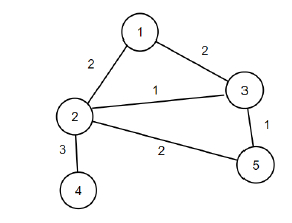n개의 정점과 m개의 간선을 가진 가중치 무방향 그래프가 있다고 가정합니다. 그래프의 점수는 그래프에 있는 모든 간선의 가중치의 합으로 정의됩니다. 간선 가중치는 음수일 수 있으며, 이를 제거하면 그래프의 점수가 높아집니다. 우리가 해야 할 일은 그래프의 연결성을 유지하면서 그래프의 간선을 제거하여 그래프의 점수를 최소화하는 것입니다. 줄일 수 있는 최대 점수를 찾아야 합니다.
그래프는 '가장자리' 배열 형식으로 제공되며, 여기서 각 요소는 {weight, {vertex1, vertex2}} 형식입니다.
따라서 입력이 n = 5, m = 6, edge = {{2, {1, 2}}, {2, {1, 3}}, {1, {2, 3}}, {3이라면 , {2, 4}}, {2, {2, 5}}, {1, {3, 5}}}, 그러면 출력은 4가 됩니다.

그래프에서 간선 (1, 2)과 (2, 5)를 제거하면 총 점수 감소는 4가 되고 그래프는 계속 연결된 상태로 유지됩니다.
이 문제를 해결하기 위해 다음 단계를 따릅니다.
cnum := 0
Define an array par of size: 100.
Define an array dim of size: 100.
Define a function make(), this will take v,
par[v] := v
dim[v] := 1
Define a function find(), this will take v,
if par[v] is same as v, then:
return v
return par[v] = find(par[v])
Define a function unify(), this will take a, b,
a := find(a)
b := find(b)
if a is not equal to b, then:
(decrease cnum by 1)
if dim[a] > dim[b], then:
swap values of (a, b)
par[a] := b
dim[b] := dim[b] + dim[a]
cnum := n
sort the array edges based on edge weights
for initialize i := 1, when i <= n, update (increase i by 1), do:
make(i)
res := 0
for each edge in edges, do:
a := first vertex of edge
b := second vertex of edge
weight := weight of edge
if find(a) is same as find(b), then:
if weight >= 0, then:
res := res + 1 * weight
Ignore following part, skip to the next iteration
if cnum is same as 1, then:
if weight >= 0, then:
res := res + 1 * weight
Otherwise
unify(a, b)
return res더 나은 이해를 위해 다음 구현을 살펴보겠습니다. -
#include <bits/stdc++.h>
using namespace std;
int cnum = 0;
int par[100];
int dim[100];
void make(int v){
par[v] = v;
dim[v] = 1;
}
int find(int v){
if(par[v] == v)
return v;
return par[v] = find(par[v]);
}
void unify(int a, int b){
a = find(a); b = find(b);
if(a != b){
cnum--; if(dim[a] > dim[b]){
swap(a, b);
}
par[a] = b; dim[b] += dim[a];
}
}
int solve(int n, int m, vector <pair <int, pair<int,int>>> edges){
cnum = n;
sort(edges.begin(), edges.end());
for(int i = 1; i <= n; i++)
make(i);
int res = 0;
for(auto &edge : edges){
int a = edge.second.first;
int b = edge.second.second;
int weight = edge.first;
if(find(a) == find(b)) {
if(weight >= 0)
res += 1 * weight;
continue;
}
if(cnum == 1){
if(weight >= 0)
res += 1 * weight;
} else{
unify(a, b);
}
}
return res;
}
int main() {
int n = 5, m = 6;
vector <pair<int, pair<int,int>>> edges = {{2, {1, 2}}, {2, {1, 3}}, {1, {2, 3}}, {3, {2, 4}}, {2, {2, 5}}, {1, {3, 5}}};
cout<< solve(n, m, edges);
return 0;
}5, 6, {{2, {1, 2}}, {2, {1, 3}}, {1, {2, 3}}, {3, {2, 4}}, {2, {2, 5}}, {1, {3, 5}}}
4
위 내용은 그래프에서 줄일 수 있는 최대 점수 구성 요소를 찾는 C++ 프로그램의 상세 내용입니다. 자세한 내용은 PHP 중국어 웹사이트의 기타 관련 기사를 참조하세요!